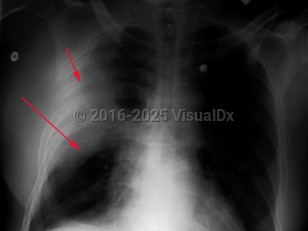Klebsiella pneumonia
Alerts and Notices
Important News & Links
Synopsis

Klebsiella pneumonia is caused by Klebsiella pneumoniae, an enteric gram-negative rod. Klebsiella pneumoniae usually enters the lung via aspiration of oral secretions and can result in both community-acquired pneumonia as well as hospital-acquired pneumonia. Most cases occur in the hospital.
Middle-aged or older men are affected most frequently, and alcohol use disorder is the most common risk factor. Other patients at risk include those with diabetes or a malignancy, the elderly in nursing homes, debilitated patients receiving antibiotics, and those with chronic cardiopulmonary disease and renal disease.
The onset of symptoms is sudden with pleuritic chest pain, chills, prostration, moderate fever, dyspnea, and productive cough. The sputum can be thick and bloody, greenish, and also have a "currant jelly" appearance. The white blood cell count is usually elevated, but neutropenia appears to be frequent in those with cirrhosis and Klebsiella infection. Bacteremia can occur in up to 25% of cases. Complications can include lung abscesses, pericarditis, empyema, and meningitis. Rarely, there can be eye complications. In hypervirulent cases, pyogenic abscesses can form in the liver, central nervous system, urinary tract, soft tissues, and other sites.
Middle-aged or older men are affected most frequently, and alcohol use disorder is the most common risk factor. Other patients at risk include those with diabetes or a malignancy, the elderly in nursing homes, debilitated patients receiving antibiotics, and those with chronic cardiopulmonary disease and renal disease.
The onset of symptoms is sudden with pleuritic chest pain, chills, prostration, moderate fever, dyspnea, and productive cough. The sputum can be thick and bloody, greenish, and also have a "currant jelly" appearance. The white blood cell count is usually elevated, but neutropenia appears to be frequent in those with cirrhosis and Klebsiella infection. Bacteremia can occur in up to 25% of cases. Complications can include lung abscesses, pericarditis, empyema, and meningitis. Rarely, there can be eye complications. In hypervirulent cases, pyogenic abscesses can form in the liver, central nervous system, urinary tract, soft tissues, and other sites.
Codes
ICD10CM:
J15.0 – Pneumonia due to Klebsiella pneumoniae
SNOMEDCT:
64479007 – Pneumonia due to Klebsiella pneumoniae
J15.0 – Pneumonia due to Klebsiella pneumoniae
SNOMEDCT:
64479007 – Pneumonia due to Klebsiella pneumoniae
Look For
Subscription Required
Diagnostic Pearls
Subscription Required
Differential Diagnosis & Pitfalls

To perform a comparison, select diagnoses from the classic differential
Subscription Required
Best Tests
Subscription Required
Management Pearls
Subscription Required
Therapy
Subscription Required
References
Subscription Required
Last Updated:09/08/2021
Klebsiella pneumonia

